AUGUST 2021
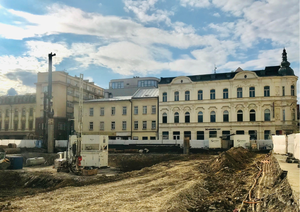 Building work at Nové Lauby has begun
Building work at Nové Lauby has begun
The Nové Lauby residential complex has become a synonym for the transformation that Ostrava’s city centre will undergo in the upcoming years. In accordance with the City’s strategic goal of revitalizing Ostrava’s historic core, the complex will attract new permanent residents who will help to breathe life into the city centre even when the shops and offices are shut.
The residential complex is being built on a formerly vacant site, where buildings used to stand before they were demolished due to their poor technical condition. The site is bounded by four streets: Muzejní, Velká, Dlouhá and Pivovarská. The complex will consist of five conjoined buildings sharing an inner atrium area, with a multifunctional ground level (including shops and services) and an underground parking garage. By filling a long-vacant lot, the project will restore the original urban structure at the site.
The complex has been designed by the studio ZNAMENÍ ČTYŘ – ARCHITEKTI S.R.O., and the building work has been contracted to a private investor, the BBB Nové Lauby consortium.
An archaeological survey was carried out at the site from 2019 to 2021, and building work began at the end of July this year. Construction will be completed in 2024 when the complex will welcome its first residents.
On completion, the City of Ostrava will purchase 31 apartments from the investor (out of a total 85 apartments), plus 119 parking spaces and 17 cellar units. The City-owned apartments will not be sold off, but will instead be offered for rental. The parking spaces will serve not only residents, but also the general public.
For more information on the project see HERE.
 Interest in private apartment rentals is growing
Interest in private apartment rentals is growing
According to a report published in July by the consultants Colliers in conjunction with the legal firms Kinstellar and Greenberg Traurig, interest in private apartment rentals is growing in Central and Eastern Europe. This growth of interest is reflected in the growing number of rental apartment complexes currently being built, which are scheduled for completion in the upcoming years.
Interest in rented housing is a relatively new trend in Central and Eastern Europe, where people have historically preferred to own their homes. However, recent years have seen an upsurge in purchases of buy-to-let apartments, as private buyers invest in residential properties that they then offer for rental. This investment strategy reflects the poor yield from savings in banks, as well as the low cost of mortgage borrowing. However, it is clear that the main driving force behind the boom in residential investments does not come from individual private buyers, but from large developers.
What is the target group for these rentals? Mainly young professionals, as well as international residents who have not yet decided to settle permanently. Developers’ projects are aimed mainly at these customers, who usually demand a higher-than-average standard of services.
The City of Ostrava has responded to the growing interest in rental apartments, coordinating new residential projects (especially in the city centre) which will attract tenants seeking high-quality apartments. This in turn will help revitalize and breathe new life into the historic city centre – which is one of the City’s main strategic goals. Recently the City has completed the reconstruction of two apartment blocks (Střelniční St., Husova St. - information only in Czech), which now offer comfortable modern accommodation, as well as building a brand-new apartment complex in Janáčkova Street.
The Janáčkova Street complex is not the last residential development in central Ostrava. Probably the most eagerly awaited project is the Nové Lauby complex, directly adjacent to the city’s main square – see the article above.
Source: Colliers
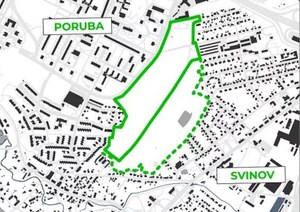 A new residential quarter will be created between Poruba and Svinov
A new residential quarter will be created between Poruba and Svinov
On 18 August 2021, Ostrava’s Municipal Studio for Urban Planning and Architecture (MAPPA) ceremonially unveiled an urban planning study focusing on a site bounded by Polská St. and Mongolská St. in Poruba. This 23-hectare site – which is currently vacant, unbuilt land – will become a brand-new residential quarter acting as a natural link between Poruba’s 5th district and the low-rise residential area of Svinov.
To ensure that this vision becomes a reality, MAPPA was tasked with producing an urban planning study that will delineate clear parameters for the new residential developments and public spaces. The study sets out the most appropriate routes of future streets as well as the heights of the buildings, and it defines the locations and types of public spaces. The study also specifies measures to ensure that the new quarter will be a quiet and peaceful place to live, as well as delineating easy pedestrian and cycle routes between Svinov and Poruba.
The location is zoned for apartment blocks and individual houses. The urban planning study specifies clear parameters for developments to be sited on City-owned land, in order to ensure that the new quarter offers attractive, high-quality residential units.
The study involved contributions by all key stakeholders – the City, its municipal districts, and developers. The final version of the study represents a consensus shared by all these key actors.
The study will be presented to the public on 21 September 2021. The MAPPA team and representatives of the City will be present to respond to questions from the general public.
For more information, as well as a downloadable copy of the study, see HERE (only in Czech).
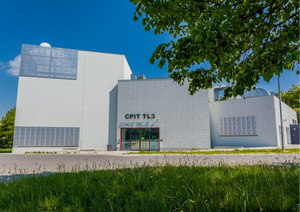 Ostrava’s Technical University has a new lab complex
Ostrava’s Technical University has a new lab complex
The tech sector (including IT, mathematics, the automotive industry and electronics) is one of the best-paid sectors in the labour market. Graduates of Ostrava’s VŠB Technical University have no problems finding interesting, well-remunerated jobs in this sector, and many of them begin pursuing their future careers while still studying.
The University’s Faculty of Electrical Engineering and Computer Science boasts state-of-the-art facilities and equipment, and it recently completed the construction of a new complex for lab-based teaching – a “testbed” for elements of Industry 4.0, automotive, home care and energy systems in buildings.
The complex consists of three laboratory buildings including a photovoltaic power plant and a fast charging station for electric vehicles.
The automotive lab focuses on e-mobility and autonomous driving technologies. The home care lab includes two simulated apartments enabling researchers to monitor people’s behaviours in order to develop new biomedical engineering technologies. The smart factory focuses on robotics, artificial intelligence, virtual and enhanced reality, and other fields. The complex enables students to improve their practical skills by using its sophisticated technologies and cooperating with the University’s industry partners.
The lab complex was designed by Ostrava-based Projektstudio. Visually, the complex is dominated by a novel feature – a façade finished in light grey relief plasterwork with printed motifs depicting linkages.
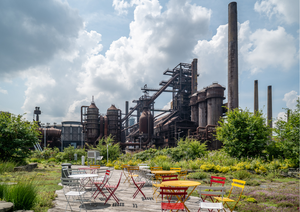 The hidden potential of Ostrava’s brownfields
The hidden potential of Ostrava’s brownfields
Brownfields are unused areas of land or buildings that represent a huge reservoir of unharnessed potential. In Western Europe, brownfields first began to appear in the 1960s, while in the Czech Republic they emerged as part of the post-communist economic transformation in the 1990s. Brownfields are silent witnesses to the former glory of our industrial past – yet they are also neglected, unused sites which fail to meet basic safety standards, and the private sector is usually unwilling to convert them for new use. Brownfields are often located in the central parts of towns and cities, where they represent an obstacle to sustainable urban development.
For Ostrava and its region – formerly a major centre of heavy industry – brownfields are of crucial importance. Sites and buildings previously used for mining, iron and steel production or other industries are scattered throughout the city. It has been estimated that 8.9% of Ostrava’s surface area (19.04 square kilometres) is affected by former industrial activity.
The largest brownfields in Ostrava are the former Karolina area, Lower Vítkovice and Hrušov. These three sites represent examples of best practice for revitalizing brownfield areas. Lower Vítkovice has undergone a huge transformation already, yet much of the area still awaits redevelopment. This iconic former ironworks complex has become a vibrant centre for tourism, culture and education. Besides the historic ironworks, other visitor attractions include the recently opened branch of the National Museum of Agriculture as well as two surviving blast furnaces that are set to be converted into the Museum+ centre, which will present exhibits from the National Museum drawing from its natural history, science and technology, art and history collections. Other developments planned for Lower Vítkovice include a new head office and museum for the Kofola company (only in Czech) at the historic bath-house of a former coal mine (the project has unfortunately been delayed as a result of the pandemic).
The Vítkovice brownfield is also set to grow in two directions. The last issue of the Newsletter included information on an urban planning study that is currently underway, which will set out future plans for the area to the north, between the current Lower Vítkovice complex and the Karolina area. The brownfield will also expand southward with the construction of the new P3 Ostrava Central business park. The P3 project will create a business and industrial zone including warehouses and other facilities for the rapidly growing logistics and e-commerce sectors, plus sales showrooms, light industrial manufacturing premises and office developments.
A database of fully regenerated brownfields and sites that still await new use is maintained by Moravian-Silesian Investment and Development (MSID), and can be accessed here (only in Czech).
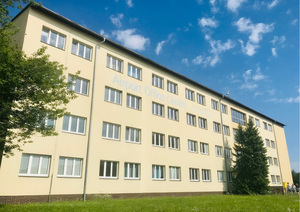 Office space available to rent at the Mošnov Administrative Centre
Office space available to rent at the Mošnov Administrative Centre
If you are looking for new office premises, the City of Ostrava is currently offering space to rent in the close vicinity of Ostrava Airport and the Ostrava-Mošnov Industrial Zone. Tenants can take full advantage of this strategic location, which enjoys ideal access by air, road, rail and public transport, plus a large car parking area (free of charge) and a number of centralized services.
Another source of added value is the location’s proximity to a number of major manufacturing and distribution companies based at the Strategic Industrial Zone (directly adjacent to the office complex).
The offices form part of the Mošnov Administrative Centre. This four-floor building currently contains 37 available office units of various sizes. The building has an elevator and is connected to the central security desk. There are full bathroom and kitchen facilities on each floor. A large parking area (free of charge) is available directly outside the building.
For more information, see the website pozemky.ostrava.cz – section PRONÁJEM (only in Czech).
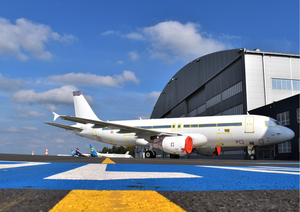 Aircraft from all over the world come to Mošnov for maintenance
Aircraft from all over the world come to Mošnov for maintenance
In recent years, the Ostrava-Mošnov Industrial Zone has undergone a rapid process of development and transformation. The zone offers a unique opportunity for investors to benefit from its strategic location next to Ostrava’s international airport. The most important part of the Mošnov development zone is the Ostrava-Mošnov Strategic Development Zone, which covers an area of 200 hectares and is situated on land owned by the City of Ostrava.
At the heart of the entire Mošnov zone is Leoš Janáček International Airport. Unfortunately, operations at the airport have recently been hit by the Covid-19 pandemic.
One of the longest-established companies at the airport – and one which has managed to adapt very flexibly to the challenges brought by the pandemic – is JOB AIR Technic, which provides aircraft repair and maintenance services. The company has been based at Mošnov since 1993. Over the years, it has received accreditation to maintain Boeing 737, Airbus A320 and A330 aircraft.
JOB AIR Technic specializes in so-called heavy maintenance, which is often necessary when an aircraft’s operator changes or the aircraft is returned to its owner by an operator which previously leased it. At the beginning of 2020, the company opened its new repair hangar including workshops and storage facilities.
In the past year, JOB AIR Technic has performed excellently despite the challenges posed by the pandemic, which paralyzed air transport globally. The company performed maintenance work on 105 aircraft and its turnover for the year totalled 659 million CZK. The company is still operating to its full capacity, though it is also planning ahead in order to respond to the aviation industry’s expected return to normal following the global pandemic.
Source of photographs JOB AIR Technic
 Ostrava’s new trams will be built in the city
Ostrava’s new trams will be built in the city
The new Škoda ForCity Smart trams that will carry passengers around Ostrava will be built by the city’s Škoda Ekova factory from the autumn of this year. Škoda Ekova was formed at the beginning of August when 100% of the shares in Ekova Electric (owned by Ostrava’s public transport company DPO) were transferred to Škoda Transportation. The name of the company was changed to reflect its new ownership. Škoda Ekova (part of the Škoda Transportation group) will focus on servicing, modernizing and repairing public transport vehicles, and it will also produce the new trams for its home city.
Škoda Transportation has a long-established presence in the Moravian-Silesian Region. Its operations in Ostrava focus on developing technologies for diagnostic, control and multimedia systems as part of its subsidiary Škoda Digital. Ostrava is also home to the group’s subsidiary Škoda Vagonka, which develops and produces rail vehicles. Škoda Vagonka has recently implemented a major expansion programme, investing over 1 billion CZK in equipment acquisition and modernization. The company has built the largest machining centre in Europe as well as a new paint shop, creating hundreds of jobs. The June issue of the Newsletter has more information on the new paint shop.
Ostrava’s public transport company (DPO) is now fully focused on providing high-quality services to its passengers. The company will no longer be active in vehicle production – a highly competitive sector that is the domain of specialist firms.
Ostrava’s new trams will meet the latest requirements. They will be fully air conditioned, offering wi-fi internet connections, USB ports for passengers to charge their mobile devices, anti-vandal surfaces, and camera systems both inside and outside the vehicles. The trams will offer passengers maximum comfort and safety as well as containing the latest technologies.
Sources: DPO, Škoda Transportation
OTHER NEWS
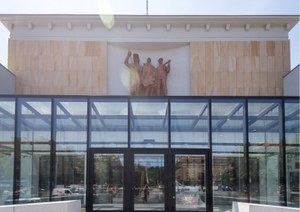 Poklad cultural centre finally reopens
Poklad cultural centre finally reopens
The Poklad Cultural Centre is a symbol of Poruba (Ostrava’s second most populous municipal district), and after a lengthy reconstruction it is now finally reopening to the public. Built in 1961, for decades Poklad was at the heart of Poruba’s cultural life, not only hosting concerts and theatrical performances but also providing a meeting-place for a wide range of clubs and hobby groups.
After fifty years of continual use, it became necessary to carry out a complete reconstruction – including the heating and ventilation systems, the stage facilities and the lighting. The reconstruction began in 2021, but work was interrupted twice due to legal and technical issues.
In 2018 the City announced the third public tender for the reconstruction work. At the beginning of April 2019 the City Council chose the contractor, and the contractual formalities were completed. The latest reconstruction began in July 2019, and this time it went smoothly according to plan.
The completely renovated cultural centre includes an auditorium with seating for 400 people, a hall for social functions, a small stage for 100 spectators, a music club, teaching rooms, rehearsal facilities and a restaurant.
The opening ceremony took place on 25 August 2021 and included a wealth of accompanying events.
See HERE for more information about the reconstruction (only in Czech).
 Ostrava will once again be the centre of the ice hockey world
Ostrava will once again be the centre of the ice hockey world
On 9 August 2021, representatives of the City of Ostrava, the Moravian-Silesian Region and the Czech Ice Hockey Federation met at the Ostravar Arena to sign a memorandum on cooperation and funding for the 2024 IIHF Ice Hockey World Championship. Ostrava will co-host the tournament alongside Prague.
The World Championship is one of the most popular sporting events worldwide, and Ostrava last hosted it in 2015. Thanks to the excellent cooperation between the two host cities Ostrava and Prague, the 2015 Championship has been rated the best-organized Championship in the IIHF’s history. It also attracted record numbers of visitors (a record which has still not been broken).
The 2024 IIHF Ice Hockey World Championship will take place from 10 May to 26 May 2024, and it will feature the world’s top 16 teams. The teams will be divided into two groups; each city will host 28 group matches and 2 quarter-finals. Under IIHF rules, the semi-finals and the final will take place in Prague.
The World Championship will attract large numbers of ice hockey fans to Ostrava, boosting the city’s international prestige as well as encouraging children to take an interest in the sport.
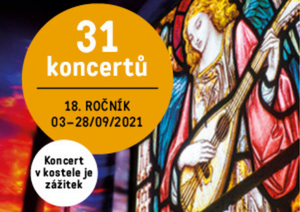 Churches throughout the region will host a festival of religious music
Churches throughout the region will host a festival of religious music
Between 3 September and 28 September 2021, churches throughout the Moravian-Silesian Region will host the 18th St. Wenceslas Music Festival. This major international celebration of religious and early music will be launched at Ostrava’s Cathedral of the Holy Saviour with a performance of Rossini’s Solemn Mass given by the Polish National Radio Symphony Orchestra. The festival will comprise 31 concerts, of which 15 will take place in Ostrava.
Among the most eagerly awaited concerts will be a performance of Dvořák’s oratorio Saint Ludmila, which will be held on 15 September – precisely 1100 years since the saint’s death.
The festival programme will also include some more novel projects, such as an electronic big band performance by the Cotatcha Orchestra (nominated for the Anděl music prize) or a concert version of the popular Czech stage musical A Ballad for a Bandit performed by the South Czech Philharmonic.
See HERE for more information about the festival.



